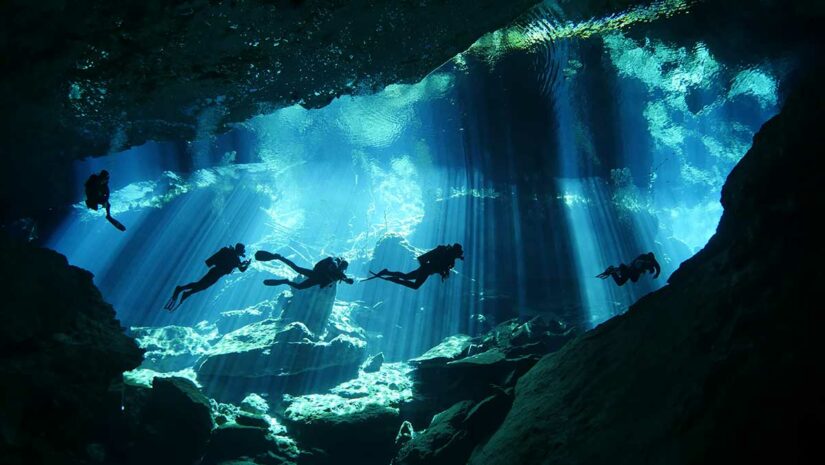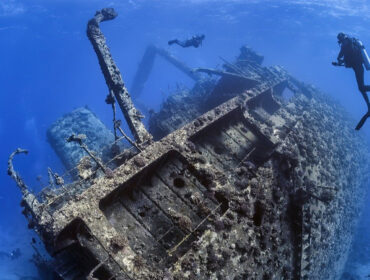Cenote diving is an adventure that immerses divers in the mysterious world of underwater sinkholes. These cenotes, often found in Mexico, are made of collapsed limestone and offer divers a unique diving experience. Cenotes have incredibly clear water, stunning rock formations and exciting light effects. These elements combined create an atmosphere that will leave a lasting impression.
Whether you’re just starting with exploring caverns or are already advancing into complicated cave systems, cenote diving offers a mix of natural beauty, historical significance and exciting underwater exploration.
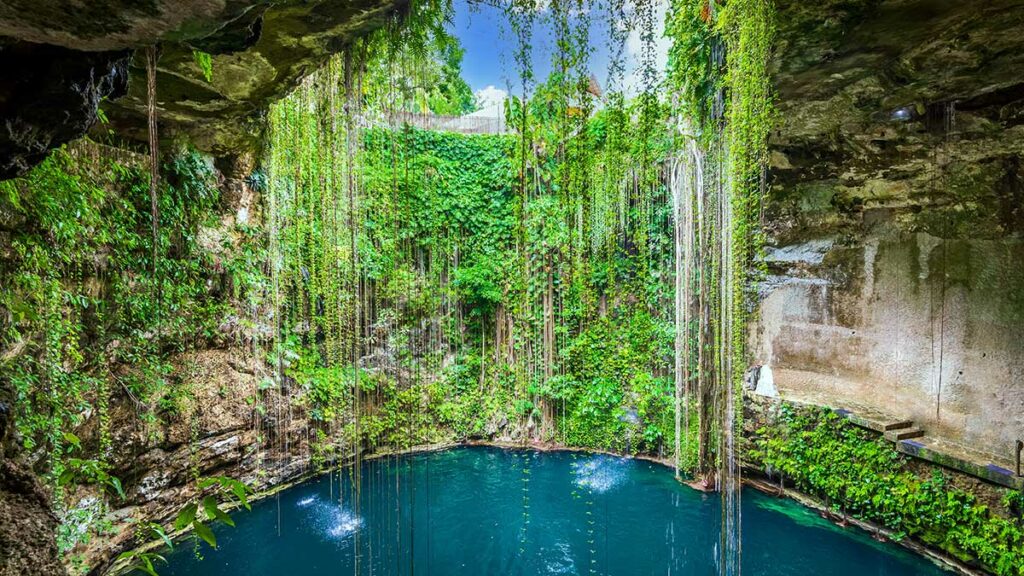
What is Cenote Diving?
Cenote diving refers to diving in underwater sinkholes, known as cenotes. Mexico, in particular, is world-famous for cenote diving because there are over 6,000 cenotes there – most in the Yucatan Peninsula. Cenotes naturally occur when limestone bedrock collapses, revealing water-filled caverns underneath. In the Yucatan Peninsula, cenote diving is gaining popularity day by day, as both recreational divers and technical divers are able to explore the cenotes as there are two ways to dive a cenote: you can do a cavern dive (for recreational divers) or a cave dive (for technical divers).
Difference between a Cavern Dive and a Cave Dive
There’s a bit of a misconception that only technical divers can dive in cenotes. This is not true at all. Recreational divers who have at least their PADI Open Water certification or an equivalent qualification can sign up for a cenote dive. The difference is that they won’t go too deep or venture into narrow passages. To be precise, a cavern dive is a dive where you’re always within 200 feet of sunlight, and two divers can comfortably pass each other. Many cenotes are suitable for these type of cavern dives. Cave dives often go deeper into the cenote system and can involve incredibly narrow passages. These types of dives require additional training and equipment.
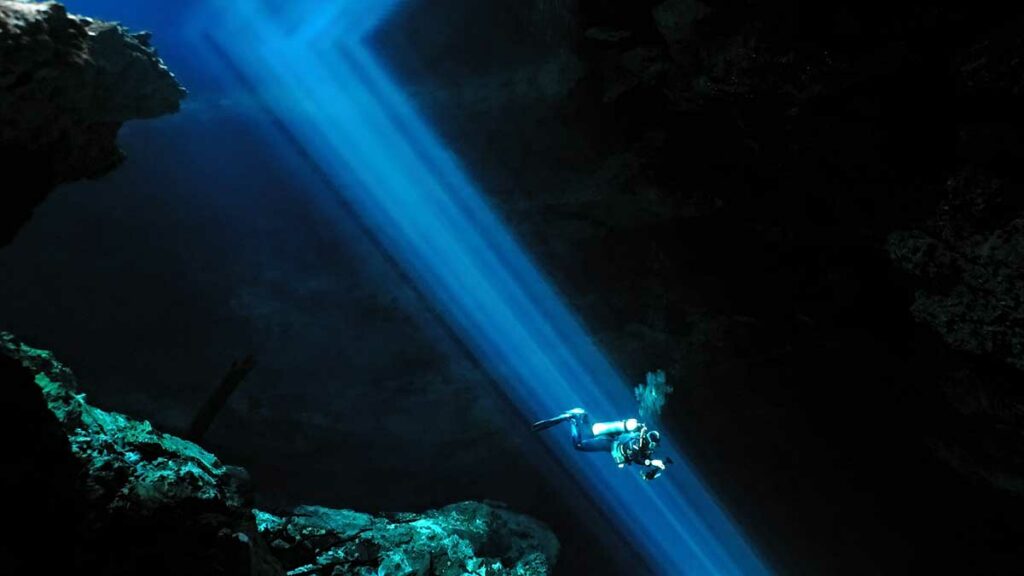
The Allure of Cenote Diving
Cenote diving offers a unique and magical experience that attracts divers from all over the world. Cenotes have an incomparable mysterious beauty. Sunlight casts a mesmerizing light through the openings, which combines beautifully with the calm and crystal clear waters below. On a clear day, a diver will see rays of light shining playfully through the water, sparkling and lighting up the darker spots of the cenote and the hidden caves.
The visibility in cenotes is amazing, allowing divers to enjoy the cenote’s unique rock formations. Stalactites and stalagmites create fascinating natural sculptures that turn the underwater landscape into a surreal world. Diving into pristine waters and exploring these amazing geological formations is an experience that no other type of dive site can offer.
Cenotes are also home to diverse flora and fauna, making every dive an opportunity to discover a dynamic ecosystem. Divers can encounter a variety of fish and even crocodiles in these underwater paradises. Cenotes also have a rich variety of aquatic plants, such as water lilies and colorful algae, which further enhance the visual effect.
Cultural and historical significance of cenotes
To the ancient Mayans, cenotes were considered sacred and held deep spiritual significance. They believed that the cenotes were the gateway to the underworld known as “Xibalba” and were considered the entrance to the realm of the gods. The Mayans held important religious ceremonies, such as sacrifices and offerings in cenotes, to express their respect.
Cenotes have also played an important role in uncovering archaeological treasures and providing valuable insight into the ancient Mayan civilization. Over the years, divers and explorers have found many artifacts deep in the cenotes, including pottery, jewelry, tools, and human remains. These discoveries contribute to our understanding of Mayan history.
In recognition of the cultural and historical importance of cenotes, efforts have been made to preserve them. Government agencies, conservation organizations and local communities have taken steps to ensure sustainable management and conservation of the cenotes. In implementing regulations and guidelines for diving and tourism, the goal is to preserve the cultural heritage and historical value associated with these sites while promoting responsible and respectful visitor access.
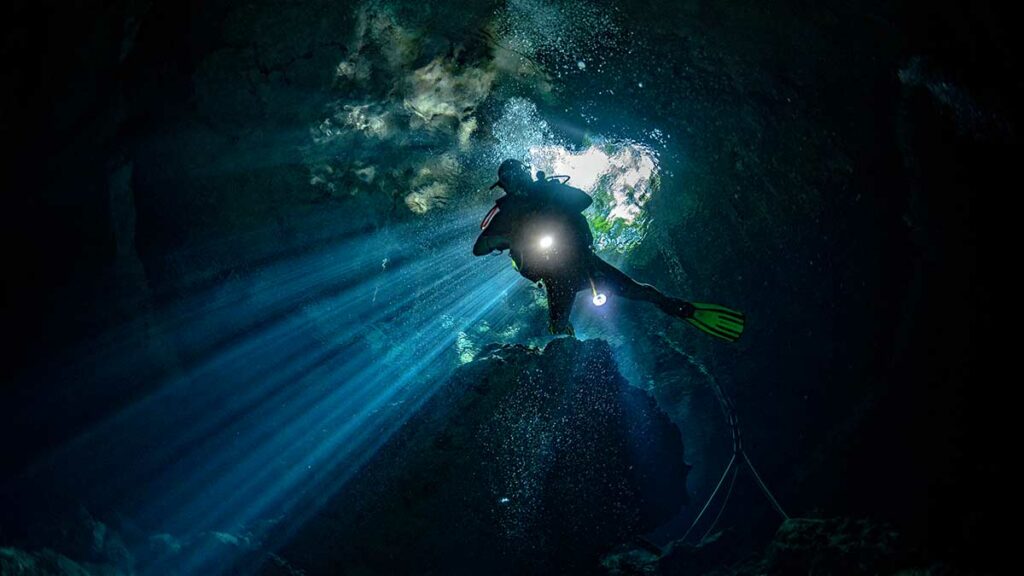
Essential Gear for Cenote Diving
Certifications
Before you can set of to go cenote diving, it is crucial to have the necessary training and certification. Recreational divers should have at least their PADI Open Water certification or an equivalent qualification. This certification ensures that divers have a good understanding of diving principles, safety procedures, and skills required for open water diving.
Additionally, divers interested in cave diving in cenotes should follow further specialized training, such as the PADI Cave Diver certification. This advanced training equips divers with the knowledge and skills necessary for safe cave exploration, including cave navigation, line handling, and emergency procedures.
Protective & insulating gear
For cenote diving, the essential gear includes normal dive gear with a few specific considerations. It is best to wear a long wetsuit and boots, as the water temperature in the cenote is cooler than in the open sea. As reaching the entry point may also involve some bushwalking, it is also important to have sturdy and protective footwear.
There’s no need for snorkels as some cenotes can pose a risk of entanglement from tree roots and branches. Although rental equipment is usually provided by dive centers, it is best to bring your own equipment as you will be familiar with that already. Since cenote diving is freshwater diving (except when you encounter haloclines, where salt water meets fresh water), lighter weights are required compared to sea diving. As the water temperature is around 77F° (25C°), a full 5mm wetsuit, boots and adjustable fins are usually used.
Dive light
Carrying a reliable dive light is highly recommended not just to enhance your cenote diving experience but especially for your own safety as you will use the light for navigation and communication. Two lights (one as a spare) is the way to go – just in case your first dive lights fails. Technical diving most likely will require line markers, safety reels, and additional gas tanks with backup gas.
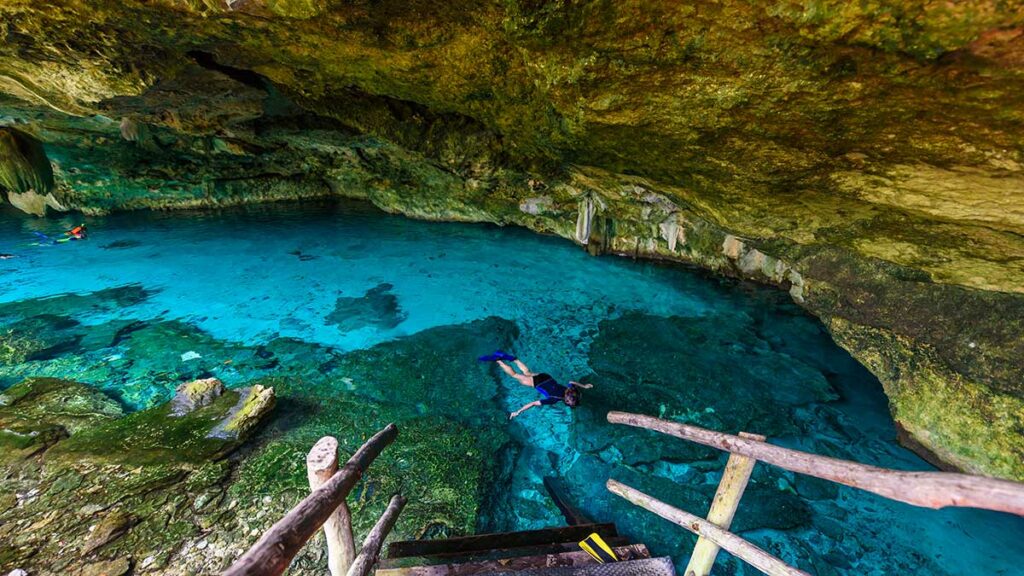
Best Locations for Cenote Diving
With over 6,000 cenotes alone in Mexico it can be difficult to know exactly which cenotes to dive. Having said that, when you’re just starting with cenote diving, you’ll be with a professional cenote guide from a dive shop. In general they’ll make sure to take you to the best locations for you. Here are some interesting cenotes we think are worth diving in:
Cenote Dos Ojos
Cenote Dos Ojos, located near Tulum, is one of the most famous and iconic cenotes in the world. Its name translates to “Two Eyes” in English, referring to the two neighboring cenotes connected by the underwater cave system. Divers can explore two different dives in Dos Ojos, the first one is the Barbie Line and the second one is the Bat Cave Line. The Barbie Line is suitable for all levels of divers, providing an opportunity to admire the mesmerizing formations and swim through the many passages. The Bat Cave Line, on the other hand, is a more advanced dive that takes you into the hidden bat cave, where you can surface and observe the bats hanging above.
Angelita Cenote
This cenote offers a unique salt diving experience where divers seem to disappear into the clouds at a height of about 30 meters. Below the clouds, the water is dark and full of dead trees. The cloud contains hydrogen sulphide, which is produced through plant decomposition.
Cenote El Pit
Only for experienced divers, El Pit is the deepest cenote in Quintana Roo at 390 feet. Crystal clear water and spectacular lighting effects reveal mounds of rock and sediment on the bottom, as well as wildlife remains and white stalactites on the ceiling. One of the notable features of El Pit is the halocline, a layer where fresh and saltwater meet. This creates a stunning visual effect as divers move through the halocline, observing the distinct transition between the two layers.
Cenote Aktun-Há
Known for snorkeling and freediving, Cenote Aktun-Há offers clear green water, underwater gardens filled with flowering plants, fish, turtles and even a friendly crocodile. This is a photographer’s favorite spot.
Cenote Chac Mool
Located in Puerto Aventuras, diving at Chac Mool starts at the adjacent cenote Little Brother, which is connected to Chac Mool through a small tunnel. As divers enter the cenote, beautiful natural light illuminates the entrance, creating a picturesque setting. Besides that, Chac Mool has fascinating halos and stalactites. There is also an air-filled cathedral where divers can enter the water.
Cenote Kukulkan
Located near Cenote Chac Mool, with its mythical entrance, the sun creates amazing light effects in the crystal clear water at Cenote Kukulkan. Fossils, wall crystals, and the famous haloclines add charm to this cenote. The infrastructure surrounding Cenote Kukulkan is well-developed, making it a convenient and accessible dive site. There are facilities available, including a small restaurant.
Cenote Chikin Ha
South of Puerto Aventuras, Cenote Chikin Ha is great for cave and cavern diving. It has good infrastructure and even a snorkeling route. Divers can explore amazing light effects, remarkable salt slopes, and impressive white rock formations. The surfaces between the roots of tropical trees offer the opportunity to see birds, and the nearby Arcoiris cenote lives up to its name, which means “rainbow”.
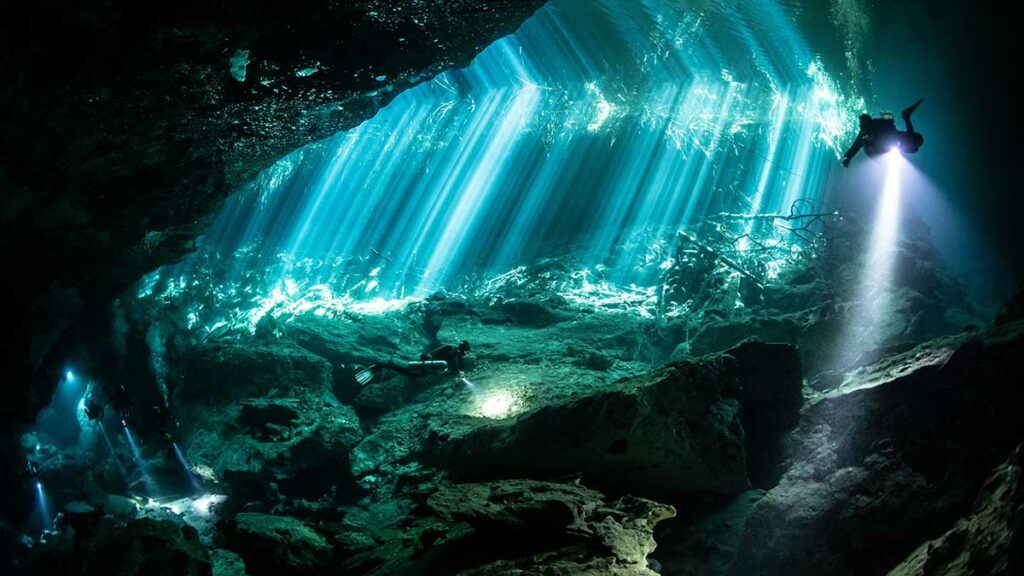
Cenote Diving as a Transformative Experience
Cenote diving is not just a diving activity; it can be a transformative experience that touches every aspect of the human being. Cenotes provide a unique environment where divers can immerse themselves in pristine natural beauty. The serene atmosphere, crystal clear waters, and stunning geological formations create a sense of harmony and connection with the natural world. This connection can evoke a deep sense of awe and wonder, awakening a spiritual connection to the underwater realm and the forces of nature that shape it.
Cenote diving also often presents divers with unique challenges, such as navigating caves or managing buoyancy in different layers of water. By overcoming these challenges, divers experience personal growth, overcome fears, and build confidence. The sense of accomplishment that comes from learning new skills and pushing your personal limits can extend beyond diving and have a positive impact on other areas of your life.
Cenote diving will undoubtedly leave you with memories and stories to cherish for a lifetime. The unique beauty and mystery of the cenote and shared sense of adventure with your diving buddies will leave a lasting impression. These memories and stories become part of a personal narrative, inspiring and enriching future experiences.
Cenote Diving: Frequently Asked Questions
Diving in cenotes can be safe when you take proper precautions. It is important to be with a professional cave guide or have the necessary training, such as a cave diving certification.
Yes, beginners can dive in cenotes, but certain cenotes are more suitable for entry-level divers. Cavern dives are accessible to those with open water certifications. However, cave dives, which involve more complex navigation and potentially tighter spaces, require specialized training and experience.
The deepest cenote dive discovered so far is El Pit in Quintana Roo, Mexico. This cenote has a depth of approximately 390 feet. El Pit offers experienced divers the opportunity to explore the deepest parts of Mexico.
It is generally not recommended to drink cenote water. Although cenote water is naturally filtered through limestone, it is considered fresh water and may still contain bacteria. It is safer to bring drinking water with you to the cenote to avoid health risks.
Conclusion
Cenote diving is an unforgettable experience that combines the charm of nature, the thrill of discovery and the beauty of the underwater landscape. It provides opportunities to connect with the natural world, overcome personal challenges, and create lasting memories. Whether witnessing the delicate stalagmites of Dos Ojos, diving the stunning haloclines of Angelitas, or exploring the depths of El Pit, each cenote offers its own unique view. Cenote diving reveals the secrets of these ancient geological formations, developing a sense of adventure and an appreciation for the delicate balance between land and water.

